-
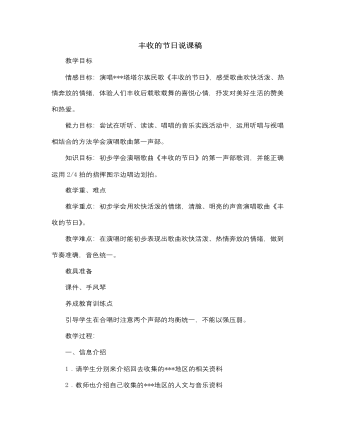
人音版小学音乐五年级上册丰收的节日说课稿
教学目标情感目标:演唱***塔塔尔族民歌《丰收的节日》,感受歌曲欢快活泼、热情奔放的情绪,体验人们丰收后载歌载舞的喜悦心情,抒发对美好生活的赞美和热爱。能力目标:尝试在听听、读读、唱唱的音乐实践活动中,运用听唱与视唱相结合的方法学会演唱歌曲第一声部。知识目标:初步学会演唱歌曲《丰收的节日》的第一声部歌词,并能正确运用2/4拍的指挥图示边唱边划拍。教学重、难点 教学重点:初步学会用欢快活泼的情绪,清脆、明亮的声音演唱歌曲《丰收的节日》。 教学难点:在演唱时能初步表现出歌曲欢快活泼、热情奔放的情绪,做到节奏准确,音色统一。 教具准备课件、手风琴养成教育训练点引导学生在合唱时注意两个声部的均衡统一,不能以强压弱。
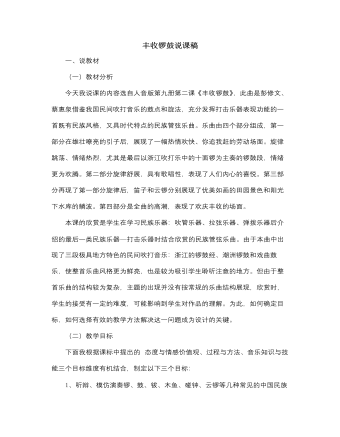
人音版小学音乐五年级上册丰收锣鼓说课稿
(3)播放第三部分。重点引导学生从笛子和云锣的演奏中展开丰富想象. 帮助学生养成从“音乐”的角度分析作品的习惯。(4)第四部分的聆听由于与第一部分较为相似,我主要通过音乐速度的变化启发学生感受音乐的变化。3、完整复听 拓展延伸为了使学生对乐曲对民族管弦乐队有更深入的印象,我借助录象,请学生边听边看,并牵引出民族管弦乐队的演出空间布局。随后要求学生即兴对照画面,把全班分为四组按照四种民族乐器分类模仿管弦乐队演出样式,随《丰收锣鼓》音乐徒手演奏。不仅能有效激发孩子对民族音乐的兴趣,同时也进一步复习巩固了民族乐器的四个分类。把音乐课堂推向了高潮。最后一个环节就是小结部分,请学生回去后搜集相关的民乐资料,使学生通过本课的学习更加关注民族音乐。

人音版小学音乐五年级上册嘎达梅林说课稿
设计意图:在音乐欣赏中加入律动,使学生能更好的体验和感受音乐,感受在草原上的驰骋和两军交战的厮杀。律动还能活跃课堂,调动学生情绪。3、听完这段音乐,请你想一想(1)音乐把你带到了什么样的场景中?(2)乐曲中的马蹄节奏是由什么乐器演奏的?设计意图:发挥学生的音乐想象力和创造力。再现部1、听再现部音乐,提问:(1)嘎达梅林的草原主题和呈示部所出现的相比,在音乐情绪上有何不同?(2)英雄倒下了,嘎达梅林的主题出现了,它出现了几次?它在音乐情绪上是如何发展变化的?(3)乐曲最后是以什么主题结束的?预示着什么?设计意图:体会节奏、旋律、音色、力度等音乐要素在表现音乐情绪上的作用。2、引导学生说出乐曲的曲式结构设计意图:培养学生分析乐曲结构的能力。检验之前所学知识。
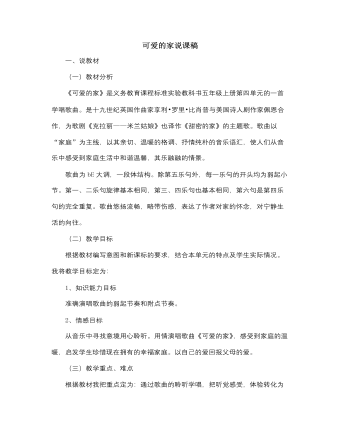
人音版小学音乐五年级上册可爱的家说课稿
4、带唱利用电子琴伴奏,教师带唱的方式,引导学生唱好弱起节奏和附点节奏。第三个环节延伸[设计理念:新课改提倡学科综合。依据这一理念,我在这一环节中让学生动手画一画,体现了音乐与美术的联系,让学生从画中体会家的温馨。再用歌声表达自己对家的感情。1、画一画让学生动手画一画自己的家。提示学生家是怎么样的?有哪些人?2、说一说先让学生说一说自己画的“家”(可以是想象的家),再说说自己“可爱的家”(真实的家),启发学生感受到父母对孩子的爱是无私的爱,启发学生珍惜现在拥有的幸福家庭,以自己的爱去回报父母的爱。3、唱一唱让学生把听觉感受、体验转化为自我表现。我让个别学生来演唱,强调学生用“自然”、“自主”、“自信”有表情的来演唱。
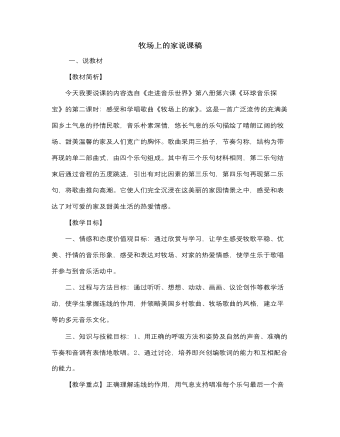
人音版小学音乐五年级上册牧场上的家说课稿
朴素深情悠长气息松散的节奏晴朗辽阔甜美温馨宽广的胸怀5、当学生唱两三次后,歌词就唱得较熟了,这时可以启发学生处理好歌曲中A乐句与B乐句的演唱力度,唱出mf与mp的力度对比。还可以启发他们用不同的演唱形式来表现音乐。6、教师范唱,最后全班用高位置的混声和圆润的音色来深情地演唱歌曲《牧场上的家》,尽情地表达对家乡的热爱。7、展示评价三、第三环节:拓展创编歌词(10分钟)听中编。同学们自编歌词,尽情歌唱自己的家。如:“猎德的家”、“我的家”、等。引导学生可根据我校综合实践课程的特色来创编歌词,歌唱猎德村改造前后的变化或心理感受。这时采用示范的方式展示和演唱老师创作的歌词,再让小组讨论并展示,还可让他们加上自制的打击乐器伴奏。最后是中肯的评价。
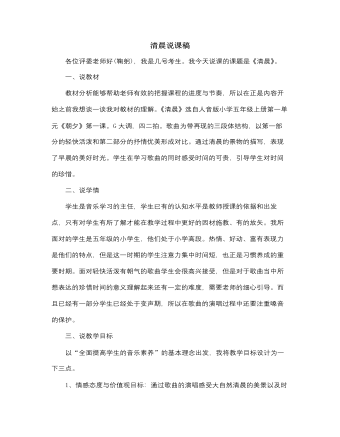
人音版小学音乐五年级上册清晨说课稿
让学生自主的用各种自己喜欢的打击乐器来拍打节奏,感受节奏的活泼欢快。(节奏示范)通过让同学们自选自己喜欢的打击乐器来拍打节奏可以激发学生们对节奏学习的积极性,从而让枯燥的节奏练习变的更加生动,我还会给学生分组并合作拍打节奏。感受不同的打击乐器给节奏增添的色彩。(3)歌曲的优美在学生能够完整的哼唱旋律和拍打节奏之后,我会引导学生自主的将旋律和歌词相结合的演唱出来,我谈伴奏。(完整歌曲示范)通过三遍又慢到快的练习,学生基本能够完整的演唱歌曲。在三遍的练习过程中学生可以明显感受到自己在歌唱方面的进步。从而更好地激发学生的歌唱兴趣以及自主学习歌唱的能力。这首曲子的歌唱顺序是需要学生特别注意的,其中有反复记号D.C. 我会带领学生一起学习这个反复记号的意思是从头反复到Fine处结束。在学生掌握反复记号之后,再次带领学生以正确的演唱顺序来进行歌曲的演唱。
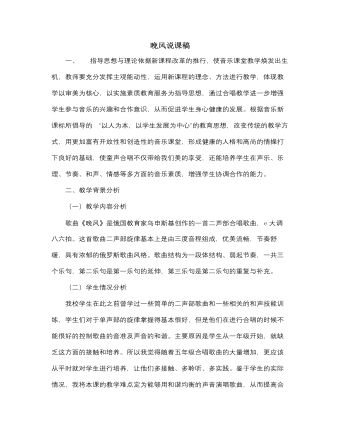
人音版小学音乐五年级上册晚风说课稿
在这一环节里我设计了让学生们利用高位置的声音轻声朗诵歌词,来理解歌词内容及其主题思想,便于他们在演唱时把握感情表达的分寸。 第六环节是拓展部分,主要是让学生们在《晚风》的旋律中了解一些有关俄罗斯的人土风情,拓展学生的视野。其实对唱好合唱来说,有一个好的“音乐的耳朵”是非常重要的。合唱讲究的是一个整体的合作,只有相互地倾听,求得准确和谐,才能保证合唱的成功。同时合唱时的音准务求准确,这样才能在大家的努力下,共同创造出优美动听的和声,所以每个人对自己所发出的声音,要做到“心”里有数,而这种感觉的建立,有很大一部分依赖于“音乐的耳朵”,要唱得好,首先要听得好。在平时的课堂教学中,要让学生多听,听录音、听教师范唱、听琴弹奏、听学生唱,在多听中培养自己音乐的耳朵。
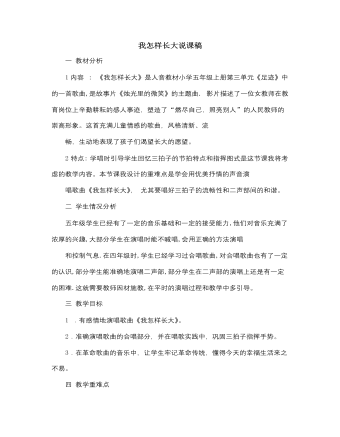
人音版小学音乐五年级上册我怎样长大说课稿
我找了几名音准较好的学生来学习低声部的旋律,然后再把两声部合起来,音准较好的学生和我来扮演小树演唱低声部,大部分学生扮演蓝天演唱高声部。注意结束句的气息控制,指导学生用循环呼吸。这样,从先唱谱再唱词;先唱高声部,再两声部合唱。由简到难,逐步地演唱歌曲。降低了学生学习二声部歌曲的难度,也提高了课堂的时效性。4 表现歌曲引导学生边打拍子边分角色有感情的演唱歌曲,感受三拍子的音乐特点,进而唱出歌曲三拍子的流畅性和歌曲的情绪。使学生对歌曲更加熟悉。 (还可以加动作表演歌曲 )5 拓展延伸引发学生思考:我要怎样长大?从而激发学生在成长的路上要努力学习/不怕困难等。6课堂小结最后的小结,我让学生在音乐声中把自己的愿望都写在了卡片上,激励他们去为了自己的理想好好学习,努力奋斗,使歌曲的情感得到了升华。
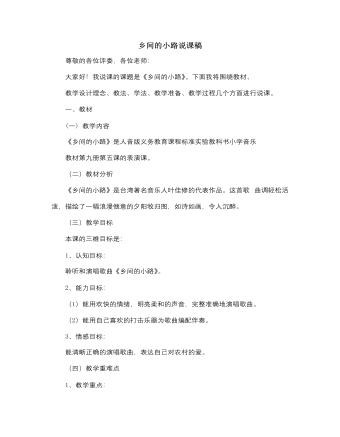
人音版小学音乐五年级上册乡间的小路说课稿
再让学生用“啦”字哼唱歌谱,让学生学会自主学习。跟琴哼唱歌词。结尾句处理(渐弱)注重细节,突出重难点。学会歌曲后做情感处理:在悠扬的音乐声中播放视频乡间的小路,看有哪些景物,对比身处乡间和城市的环境,引导学生用轻松愉快的声音演唱。完整、熟练地演唱歌曲。(轻松富有弹性的声音和高位置唱)。接下来我用竹笛演奏《乡间的小路》,让学生理解、体验和感受不同的乡村风格。 最后让学生带着感情演唱全曲,要注意指导学生体会歌曲的演唱情绪,强调演唱声音要自然、圆润、轻柔。3、表演歌曲学会歌曲后,学生分组,用不同的演唱形式处理歌曲。如:对唱、表演唱、小合唱等。教师对每组的表现做鼓励性评价。让他们“动”起来,并融入到歌曲意境中去,更好的理解歌曲。
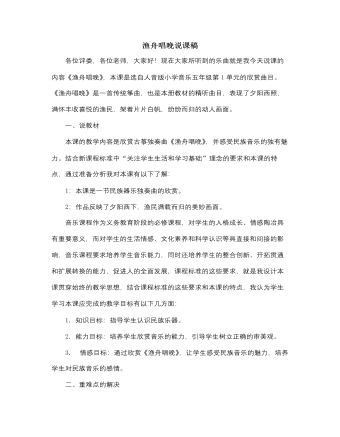
人音版小学音乐五年级上册渔舟唱晚说课稿
5、好多同学听到了一些声音,大家再认真听一遍,看还能听出什么声音来。[这个环节是本课重点,刚开始老师引导听,为了不让学生感到枯燥,我特别找了渔舟唱晚的影像资料,结合乐曲欣赏,也能让学生更直观的认知乐曲。最后的复听让学生在主题变换处给老师作出提示手势,增加了互动,也能让学生更好地掌握这首乐曲的结构。](五)拓展延伸 (约6分钟)1、简单介绍民族乐曲在国际上的影响,使学生对民族音乐有自豪感觉,培养学生热爱民族音乐,热爱祖国文化。同学们给的主题提示非常到位,说明我们已经抓住了乐曲的灵魂。《渔舟唱晚》是我国民族音乐殿堂中一颗璀璨的明珠,中国对外文化协会将此曲作为我国民族音乐的代表之一送给国际友人。我国的民族广播乐团在国外演出时,《渔舟唱晚》经常作为重要乐曲演出,并获得国际友人很高的评价。
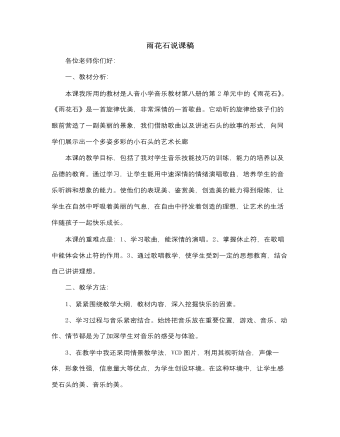
人音版小学音乐五年级上册雨花石说课稿
播放音乐《雨花石》并请学生生观看一些有关石头的图片教师有感情的范唱。教唱歌谱。在教唱歌谱中注意难点的解决,分别出示以小石头造型的节奏卡片,复习四分音符、八分音符及四分休止符。还有新学的音符,十六分休止符。学生根据直观判断时植的长短,并口读,练习。有感情的读歌词听琴声轻声哼唱歌曲。其中请学生体会与比较:运用休止符的地方你有什么样的感受?如果不用会怎样。唱一唱,比一比,说一说。请学生有感情的演唱,教师及时给予鼓励。教师总结石头可贵的精神。石头虽小,却有很多的作用等我们去发现。法国著名艺术家罗丹曾说过:“对于我们的眼睛,不是缺少美,而是缺少发现。”我想,通过这样的教学设计,让学生在音乐中认识美,在生活中寻找美,在未来里创造美,让美融入每一个孩子以上设计肯定还有一些不足之处,敬请各位老师提出宝贵意见。

新人教版高中英语必修2Unit 1 Cultural Heritage-Discovering Useful Structure教案二
This theme of the part is “ Describe people or things in greater detail”. Students have learned the grammar(restrictive relative clauses) in Book 1, and further review and consolidate its structure “prep+relative pronouns(which/whom)” and the relative adverbs(when, where and why), besides students should understand its form, meaning and functions. In this section, students should be able to express the grammar correctly in daily communication and in the writing. 1. Review the basic usages of relative pronouns and adverbs of attributive clauses . 2. Learn to use some special cases about restrictive relative clauses.3. Learn to write sentences with restrictive relative clauses flexibly according to the context.1. Review the basic usages of relative pronouns and adverbs of attributive clauses .2. Learn to use some special cases about restrictive relative clauses.3. Learn tow rite sentences with restrictive relative clauses flexibly according to the context.Step 1. Observe the following sentences, and mark the relative pronouns and the adverbs. 1. After listening to the scientists who had studied the problems, and citizens who lived near the dam, the government turned to the United Nations for help.2. Temples and other cultural sites were taken down piece by piece, and then moved and put back together again in a place where they were safe from the water.Step 2 PracticePlease complete these sentences with relative pronouns and relative adverbs and answer the following questions.Questions: 1. What is the head noun ?2. What relative words should be used ?3. What elements do they act in these sentences ?

新人教版高中英语必修2Unit 2 Wildlife Protection-Reading for Writing教案二
This lesson aims at making a poster about protecting wildlife after reading some posters. During reading students are guided to understand the content and try to summarize the posters with one sentence. Then students are guided to try to make a poster about protecting wildlife.1. Read the two posters and try to understand the summary sentences.2. Look at the two posters and try to understand what emotions they express.3. Try to summarize the features of posters4. Try to make a poster about wildlife.1. Look at the two posters and try to understand what emotions they express.2. Try to summarize the features of posters3. Try to make a poster about wildlife.Step 1 Lead inLook at the the posters on the textbook and ask:Which emotions do the posters communicate ?Step 2 Read the poster and answer the questions.1. What do you think of the animals in the poster on the left ?I think it is frightening and ugly.2. Why do we should protect the ugly animals ?All species--the good, the bad, and the ugly-- should be treated equally.The world needs all kinds--without variety, our planet cannot survive.3. Why are billions of trees being cut down every year ?To make paper for humans.4. What result will be lead to after the trees are cut down ?A lost of animal homes are being destroyed./The habitat of wildlife is being destroyed.Step 3 Find the feature of posters1. What does each poster use to stir up emotions ?On the left, it makes us a little frightened and it looks a little ugly, but it can activate our curiosity--What is it? And What is wrong with it?On the right, it makes us feel a little sad and want to protect them.

新人教版高中英语必修2Unit 1 Cultural Heritage-Reading and Thinking教案二
1. This section focuses on "Understanding how a problem was solved”, which is aimed to guide students to analyze and discuss the challenges and problems faced by cultural heritage protection during the construction of Aswan Dam, as well as the solutions. On the basis of understanding, students should pay attention to the key role of international cooperation in solving problems, and attach importance to the balance and coordination between cultural heritage protection and social and economic development. Students are encouraged to face challenges actively, be good at cooperation, and make continuous efforts to find reasonable ways and means to solve problems.2. Enable students to understand the main information and text structure of the reading text;3. Motivate students to use the reading strategy "make a timeline" according to the appropriate text genre;4. Enable students to understand how a problem was solved;5. Enable students to understand the value of protecting cultural heritage by teamwork and global community;1. Guide students to pay attention to reading strategies, such as prediction, self-questioning and scanning.2. Help students sort out the topic language about protecting cultural relics and understand the narrative characteristics of "time-event" in illustrative style3. Lead students to understand the value of protecting cultural heritage by teamwork and global community;

新人教版高中英语必修2Unit 2 Wildlife Protection-Discovering Useful Structure教案二
2.表示现阶段正在进行的被动动作(该动作在说话的瞬间未必正在进行)。Many interesting experiments are being carried out these days.(说话时,并不一定正在进行)3.表示一种经常性的被动行为,常和always,constantly 等表示频度的副词连用,这种用法常常带有赞扬或厌恶的感情色彩。He is always being praised by the leader.4.表示按计划或安排主语将要承受谓语动词所表示的动作(仅限于少数及物动词)。A party is being held tonight.Step 4 Special cases1.像take care of, look after, talk about, think of等动词与介词构成的短语用于现在进行时的被动语态时, 其中的介词不可省略。The ways to stop illegally hunting are being talked about. 2.可与部分情态动词连用,表示对正在发生的事情的推测。She may be being punished by her mother.3.有时可表示按计划或安排将要进行的一个被动动作。A celebration is being held this weekend for his success.4.某些表示“状态、心理活动、存在”等的动词,如have,want,need,love,一般不用现在进行时的被动语态,而常用一般现在时的被动语态。With the population increasing,more land is needed.5.“be+under/in+n.”可表示现在进行时的被动意义。My computer is under repair.=My computer is being repaired.

新人教版高中英语必修2Unit 2 Wildlife Protection-Reading and Thinking教案二
The theme of this unit is human and nature, focusing on the theme of wildlife protection. Nature is a complex ecosystem, in which there are delicate balance between animals and plants. Because of the role of the food chain, the extinction of one species will produce influence, causing a series of chain reaction. Large scale extinction of species will have a serious and even irreversible impact on the ecosystem, resulting in immeasurable losses. Therefore, it is of great significance to protect wild species. To protect wild species is to protect human beings themselves. The motto of this unit is "when the buying stops, the killing can too,” which is a public service advertising slogan to protect wildlife. It tells people that every rhinoceros horn, every fur, every bowl of shark fin soup, every Ivory product, and every tiger bone product, etc. consumed by human beings, are innocent wild animals slaughtered behind them. The mission of wild aid is to ban illegal trade in endangered wildlife and mitigate climate change. It aims to educate the public to reduce the consumption demand for endangered wildlife products through public publicity and improve the awareness of environmental protection.1. Improve the awareness of wildlife protection by acquiring the knowledge of wildlife protection.2. Focus on environmental protection and protection of all lives.3. Analysis of the living environment of wild animals with appropriate thinking mode.4. Skillfully use the vocabulary and grammar knowledge of this unit to cultivate self-study ability according to the unit content5. Develop cooperative learning ability through discussion and other ways1. Enable the Ss to talk about the current situation of wild animals.2. Guide the Ss to summarize the main idea of each paragraph as well as the main idea of the text.

新人教版高中英语必修2Unit 3 The Internet-Discovering Useful Structure教案二
This teaching period mainly deals with grammar “The Present Perfect Passive Voice.” To begin with, teachers should lead students to revise what they have learned about the Present Perfect Passive Voice. And then, teachers move on to stress more special cases concerning this grammar。This period carries considerable significance to the cultivation of students’ writing competence and lays a solid foundation for the basic appreciation of language beauty. The teacher is expected to enable students to master this period thoroughly and consolidate the knowledge by doing some exercises. 1. Guide students to review the basic usages of the Present Perfect Passive Voice2. Lead students to learn to use some special cases concerning the Present Perfect Passive Voice flexibly.2. Enable students to use the basic phrases structures flexibly.3. Strengthen students’ great interest in grammar learning.1. Help students to appreciate the function of the Present Perfect Passive Voice in a sentence2. Instruct students to write essays using the proper the Present Perfect Passive Voice.观察下列句子特点,总结共同点。1.(教材P28)Much has been written about the wonders of the World Wide Web.2.(教材P28)But the Internet has done much more for people than simply make life more convenient.3.(教材P28)Many people have been helped by the club.4.(教材P28)She no longer feels lonely, and her company has become quite successful.5.(教材P32)Today I thought I’d blog about a question that has been asked many times—how do you stay safe online and avoid bad experiences on the Internet?

新人教版高中英语必修2Unit 3 The Internet-Listening &Speaking&Talking教案二
From the pictures in the text and the title--- choose the best app, we can know that this part is about how to save money by using apps.Step 2 While-listening1. Laura and Xiao Bo are talking about apps. Listen to their conversation and find out what apps they want.Xiao Bo is looking for a(n) exercise app to help him get in shape.Laura would like an app for getting rich and another that will make her grades better.2. Listen again. Are the sentences true T or false F?1). Both of Xiao Bo's apps keep track of the steps he takes._____2). Xiao Bo's second app can help him make a fitness plan._____3). Laura needs an app that will help her get discounts.______4). Laura needs an app that will add money to her bank account._______F T F T3. Listen once more and tick the sentence you hear. Underline the words used to express predictions, guesses, and beliefs.Predictions, Guesses, and Beliefs________It might help me walk more.________My guess is that it wouldn't work.________I imagine this app would help me get fit faster________I suppose that would be good.________I guess you could save a little with this app.________I suppose there would be some problems, too.________I believe this app could help me get thinner.

新人教版高中英语必修2Unit 3 The Internet-Reading and Thinking教案二
Q5:What's Jan's next goal?Her next goal is to start a charity website to raise money for children in poor countries.Q6:What can we learn from her experiences?We learn that when we go through tough times, we can find help and support from other people online. We learn that we can feel less lonelyStep 5: While reading---rethinkingQ1: What is Jan’s attitude to the Internet ?Thankful/Grateful, because it has changed her and her life.Q2: What writing skills is used in the article ?Examples(Jan’s example, the 59-year-old man’s and the 61-year-old woman’s example)Q3: Can you get the main idea of the article ?The Internet has changed Jan’s life/Jan’s life has been changed by the Internet.Step 6 Post reading---Retell the storyMuch has been written about the wonders of the World Wide Web. There are countless articles (1)telling(tell) us how the Internet has made our lives more convenient. But the Internet has done a lot (2)more(much) for people than simply make life more convenient. People’s lives (3) have been changed(change) by online communities and social networks so far. Take Jan for example, who developed a serious illness that made her (4)stuck(stick) at home with only her computer to keep (5)her(she) company. She joined an online group (6)where she could share problems, support and advice with others. She considered the ability to remove the distance between people as one of the greatest (7)benefits(benefit). She was so inspired (8)that she started an IT club in which many people have been helped. She has started to learn more about how to use the Internet to make society better. Her next goal is to start a charity website to raise money (9)for children in poor countries. Jan’s life has been (10)greatly(great) improved by the Internet.

新人教版高中英语必修2Unit 3 The Internet-Reading for Writing教案二
8. However, the more polite you are, the less likely it is you will be attacked. 然而, 你越有礼貌, 你被攻击的可能性就越小。 Step 8 Writing---the articleHow to stay safe in the online chat roomToday I thought I’d blog about a question that has been asked many times--- how do you stay safe online and avoid bad experiences in the online chat room ? I’m not an expert, but many years as a blogger have taught me a thing or two.First of all, there’s the golden rule of the Internet: keep out of what makes you uneasy. Don’t post comments or click on anything. Second, protect your privacy. Don’t give out too much private information like your address, phone numbers, the ID numbers, etc. Third, be polite. If you are polite to others on the Internet, you won’t be attacked in normal situation. Finally, don’t believe in others easily and never meet someone you met online alone. It is very dangerous.Have you had any bad experiences online, or do you have some good advice for staying safe? Post your comments below!Step 9 Pair workExchange drafts with a partner. Use this checklist to help your partner revise his/her draft.1. Does the writer tell the reader what he/she know about the topic ?2. Are the tips and suggestions well organised ?3. Has the writer defined the new words ?4. Does the author include examples, comparison, or explanations ?5. Does the writer end by asking readers to leave comments and/or suggestions ?6. Can you find any grammar or spelling mistakes.Step 6 HomeworkPut up your revised draft in the classroom or read it to your class.